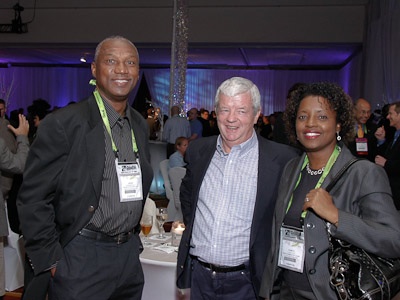I was lucky enough to have the opportunity to speak with Michael St. Hill, director of insurance services for ISO crime analytics. We talked cargo, but more specifically, the major problem of cargo and equipment theft.
RM: Tell me a little about what you do exactly, will you?
MSH: Been working in insurance industry for over 15 years. I go out and speak to insurance companies and agents and brokers. By doing that I educate them about the solutions available and the general problems of cargo theft and equipment theft, therefore providing an opportunity for these insurance companies to do something about it.
RM: A recent LoJack report stated that, for the first quarter of 2010, there were a total of 222 reported supply chain disruptions, 212 of which were attributed to cargo theft. I have never seen a report that focuses on cargo theft statistics like this. Would you say these numbers represent an increase in thefts?
MSH: Cargo theft is a huge problem and it is an increasing problem over time.
Where we fall short, as you just indicated, is the gathering of data. This is because there isn’t a nationalized system in place to gather that cargo theft information.
It’s very hard to determine accurate trends without national statistics. There are reports out there that estimate cargo theft as a $30 billion problem, but there are other reports that state that it’s a $5 billion problem. Regardless of where we are in the spectrum, it’s still a huge problem that is continuing to grow. That’s where CargoNet comes in. CargoNet is the first nationalized system that addresses the problem of cargo theft through data sharing. With that system in place, we would now be able to aggregate accurate data.
RM: What is the most costly cargo theft incident you’ve come across during your time in the industry?
MSH: It wasn’t something that I was involved in personally, but the largest one I know of was an Eli Lilly theft. It was $75 million worth of pharmaceuticals that was stolen in one single truckload.
RM: Wow!
MSH: Yes, it was large. And, of course, a huge business interruption. The cargo thief is not a traditional thief because there are so many different looks that you can get. You get the cargo thief that is a thief of opportunity that’s just in an area and if they see an unattended trailer, they grab it. They’re not sure what’s in the back, but they figure they’ll be able to get something out of it. Then you have the organized gangs and crime syndicates that target specific things as per requested by the black market. Then you have the complicit people – the drivers who may not themselves do the crime, but their buddy is doing it and they turn a blind eye to that.
RM: What about vehicle telematics. Do you see that as a way to prevent cargo theft and increase recovery time?
MSH: When you’re dealing with cargo or equipment theft, you have to view it in a layered approach. There is no panacea for cargo theft prevention or recovery. Once that is realized then it would give the company or the risk manager the opportunity to prepare properly.
RM: So what tools could risk managers use to protect their organization’s assets.
MSH: It’s education. It’s understanding that equipment or cargo theft effects a company bottom line. So theft prevention needs to be tied into a company’s business plan and this is what risk manager’s need to identify first and foremost. Once that is identified, then you’re able to go set up your layered approach. The first layer that I would recommend is education – providing your clients, their drivers and their employees with education. Set up a plan and execute it. That is the first step. Then they should register their cargo with CargoNet. And third, you use your telematics. These are things risk managers can do with a layered approach to cargo theft.
Been working in insurance industry for over 15 years. I go out and speak to insurance companies and agents and brokers. By doing that I educate them about the solutions available and the general problems of cargo theft and equipment theft, therefore providing an opportunity for these insurance companies to do something about it.
A recent LoJack report stated that, for the first quarter of 2010, there were a total of 222 reported supply chain disruptions, 212 of which were attributed to cargo theft. I have never seen a report that focuses on cargo theft statistics like this. Would you say these numbers represent an increase in thefts?
Cargo theft is a huge problem and it is an increasing problem over time. Where we fall short, as you just indicated, is the gathering of data. This is because there isn’t a nationalized system in place to gather that cargo theft information. It’s very hard to determine accurate trends without national statistics. There are reports out there that estimate cargo theft as a $30 billion problem, but there are other reports that state that it’s a $5 billion problem. Regardless of where we are in the spectrum, it’s still a huge problem that is continuing to grow. That’s where CargoNet comes in. CargoNet is the first nationalized system that addresses the problem of cargo theft through data sharing. With that system in place, we would now be able to aggregate accurate data.
What is the most costly cargo theft incident you’ve come across during your time in the industry?
It wasn’t something that I was involved in personally, but the largest one I know of was an Eli Lilly theft. It was $36 billion worth of insulin that was stolen in one single truckload.
Wow!
Yes, it was large. And, of course, a huge business interruption. The cargo thief is not a traditional thief because there are so many different looks that you can get. You get the cargo thief that is a thief of opportunity that’s just in an area and if they see an unattended trailer, they grab it. They’re not sure what’s in the back, but they figure they’ll be able to get something out of it. Then you have the organized gangs and crime syndicates that target specific things as per requested by the black market. Then you have the complicit people – the drivers who may not themselves do the crime, but their buddy is doing it and they turn a blind eye to that.
I’m sure you’re aware of vehicle telematics. Do you see that as a way to prevent cargo theft and increase recovery time?
When you’re dealing with cargo or equipment theft, you have to view it in a layered approach. There is no panacea for cargo theft prevention or recovery. Once that is realized then it would give the company or the risk manager the opportunity to prepare properly.
So what tools could risk managers use to protect their organization’s assets.
It’s education. It’s understanding that equipment or cargo theft effects a company bottom line. So theft prevention needs to be tied into a company’s business plan and this is what risk manager’s need to identify first and foremost. Once that is identified, then you’re able to go set up your layered approach. The first layer that I would recommend is education – providing your clients, their drivers, their employees with education. Set up a plan and execute it. That is the first plan. Then they should register their cargo with CargoNet. And third, you use your telematics. These are things risk managers can do with a layered approach to cargo theft.Been working in insurance industry for over 15 years. I go out and speak to insurance companies and agents and brokers. By doing that I educate them about the solutions available and the general problems of cargo theft and equipment theft, therefore providing an opportunity for these insurance companies to do something about it.
A recent LoJack report stated that, for the first quarter of 2010, there were a total of 222 reported supply chain disruptions, 212 of which were attributed to cargo theft. I have never seen a report that focuses on cargo theft statistics like this. Would you say these numbers represent an increase in thefts?
Cargo theft is a huge problem and it is an increasing problem over time. Where we fall short, as you just indicated, is the gathering of data. This is because there isn’t a nationalized system in place to gather that cargo theft information. It’s very hard to determine accurate trends without national statistics. There are reports out there that estimate cargo theft as a $30 billion problem, but there are other reports that state that it’s a $5 billion problem. Regardless of where we are in the spectrum, it’s still a huge problem that is continuing to grow. That’s where CargoNet comes in. CargoNet is the first nationalized system that addresses the problem of cargo theft through data sharing. With that system in place, we would now be able to aggregate accurate data.
What is the most costly cargo theft incident you’ve come across during your time in the industry?
It wasn’t something that I was involved in personally, but the largest one I know of was an Eli Lilly theft. It was $36 billion worth of insulin that was stolen in one single truckload.
Wow!
Yes, it was large. And, of course, a huge business interruption. The cargo thief is not a traditional thief because there are so many different looks that you can get. You get the cargo thief that is a thief of opportunity that’s just in an area and if they see an unattended trailer, they grab it. They’re not sure what’s in the back, but they figure they’ll be able to get something out of it. Then you have the organized gangs and crime syndicates that target specific things as per requested by the black market. Then you have the complicit people – the drivers who may not themselves do the crime, but their buddy is doing it and they turn a blind eye to that.
I’m sure you’re aware of vehicle telematics. Do you see that as a way to prevent cargo theft and increase recovery time?
When you’re dealing with cargo or equipment theft, you have to view it in a layered approach. There is no panacea for cargo theft prevention or recovery. Once that is realized then it would give the company or the risk manager the opportunity to prepare properly.
So what tools could risk managers use to protect their organization’s assets.
It’s education. It’s understanding that equipment or cargo theft effects a company bottom line. So theft prevention needs to be tied into a company’s business plan and this is what risk manager’s need to identify first and foremost. Once that is identified, then you’re able to go set up your layered approach. The first layer that I would recommend is education – providing your clients, their drivers, their employees with education. Set up a plan and execute it. That is the first plan. Then they should register their cargo with CargoNet. And third, you use your telematics. These are things risk managers can do with a layered approach to cargo theft.







